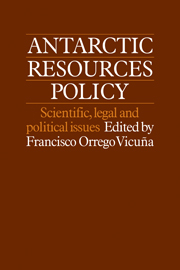Book contents
- Frontmatter
- Contents
- List of contributors
- 1 Antarctic resources policy: an introduction
- Part one The state of Antarctic knowledge and experience
- Part two The policy for the conservation of the living resources of Antarctica
- 7 Scientific and economic considerations relating to the conservation of marine living resources in Antarctica
- 8 The implementation of the Convention on the Conservation of Antarctic Marine Living Resources: needs and problems
- 9 The regime for the conservation of Antarctica's living resources
- 10 The Canberra Convention: objectives and political aspects of its negotiation
- Part three The policy for the exploration and exploitation of the mineral resources of Antarctica
- Part four Issues on Antarctica and the law of the sea
- Part five The policy for Antarctic cooperation
7 - Scientific and economic considerations relating to the conservation of marine living resources in Antarctica
Published online by Cambridge University Press: 06 July 2010
- Frontmatter
- Contents
- List of contributors
- 1 Antarctic resources policy: an introduction
- Part one The state of Antarctic knowledge and experience
- Part two The policy for the conservation of the living resources of Antarctica
- 7 Scientific and economic considerations relating to the conservation of marine living resources in Antarctica
- 8 The implementation of the Convention on the Conservation of Antarctic Marine Living Resources: needs and problems
- 9 The regime for the conservation of Antarctica's living resources
- 10 The Canberra Convention: objectives and political aspects of its negotiation
- Part three The policy for the exploration and exploitation of the mineral resources of Antarctica
- Part four Issues on Antarctica and the law of the sea
- Part five The policy for Antarctic cooperation
Summary
An important step in the conservation of marine living resources of Antarctica was achieved in 1982 with the establishment of the Commission for the Conservation of Antarctic Marine Living Resources (CCAMLR) and the conduct of its first meeting.
The Convention which establishes the Commission was concluded at a diplomatic conference in May 1980 by fifteen nations and came into force with the required eight ratifications on 7 April 1982. This period of two years from conclusion to entry into force must surely be one of the shortest such periods: particularly since it includes five months during which the Convention was held open for signature. It demonstrates the urgent need, as seen by the signatory states, to institute conservation measures in Antarctic waters.
At its first meeting the Commission appointed an Executive Secretary, authorised initial staffing levels, approved a budget for the first eighteen months of operation and set in place the necessary administrative procedures for the establishment of its headquarters and Secretariat in Hobart, Australia.
This paper contains some thoughts on the workings of the Commission and the Scientific Committee in the early stages of the implementation of the Convention.
The conservation principles
In the Convention, conservation is defined to include rational use. The conservation principles are contained in Article II and in summary they require:
– that harvested populations must not be allowed to fall below a level which ensures their greatest net annual increase;
– that depleted populations are restored to such levels;
– that ecological relationships between harvested, dependent and related populations are maintained;
– that risks are minimised of changes to the marine ecosystem that are not potentially reversible over two or three decades.
- Type
- Chapter
- Information
- Antarctic Resources PolicyScientific, Legal and Political Issues, pp. 111 - 118Publisher: Cambridge University PressPrint publication year: 1983
- 1
- Cited by



